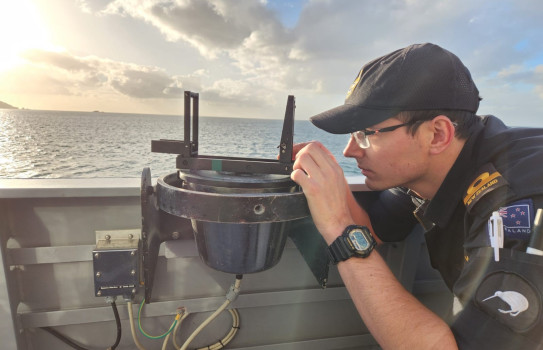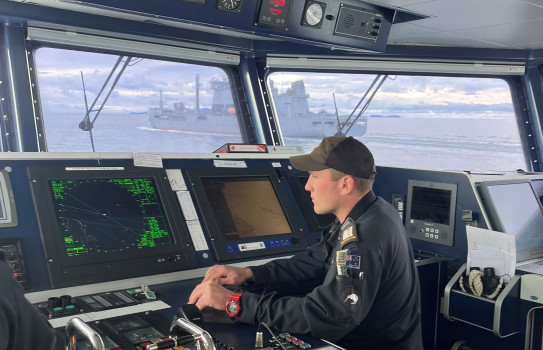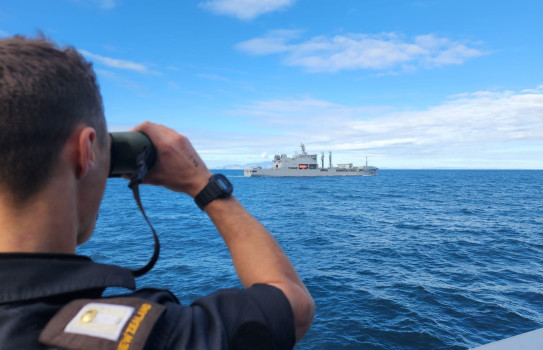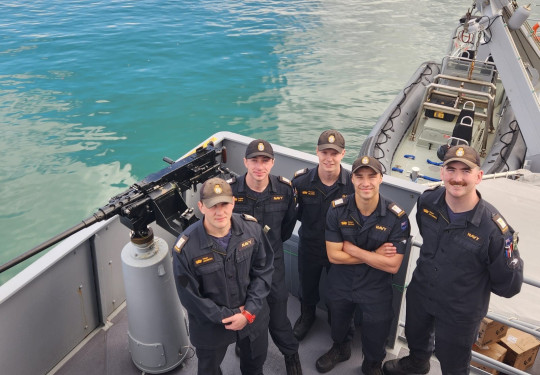Southern transit promotes good officers
Inshore Patrol Vessel HMNZS Taupo is transiting the eastern coastline of the South Island, putting the latest cohort of junior warfare officers through their paces.
31 May, 2024
For the Royal New Zealand Navy’s junior warfare officers, their first course after officer training is completing their Officer of the Watch (Basic) training. Over 16 to 20 weeks, it starts with classwork and time in a bridge simulator and finishes with sea time aboard Taupo.
At-sea training involves Taupo visiting several ports around New Zealand, to build the officers’ skills in ship handling, pilotage and maneuvering.
It’s one of Taupo’s primary roles, alongside maritime security patrols, surveillance, boarding operations and search and rescue response.
Midshipman Finbar O’Flaherty is one of six trainee officers on board Taupo.
Being on a real bridge where precision and foresight are used to make rapid, very real judgments came as a big learning curve.
The bridge is a hive of activity, he says.
“The Navigating Officer could instruct me to calculate the exact time and bearing of sunset to confirm the gyro is correct. At the same time my instructor might remind to me to keep the radar plot updated, and ask, ‘have you reported that vessel to the Commanding Officer yet? And don’t forget to put a fix on to confirm the ship’s position’.”

SLT Thomas Forbes taking a bearing from the TAUPO bridge wing.
Midshipman Thomas Milmine says sea time is the moment all the months of theory and simulator training has been building towards.
“Taking control of the bridge was a moment of realisation of the responsibility that comes with being in charge of the ship’s navigational safety and crew. It’s suddenly all very real, with the humming of the engines beneath my feet, and the rolling of the ship on the waves.
“But the routine of the bridge is ingrained in us from the start of training, and that helps us make the transition from simulator to ship easier.”
Every watch is different from the other, says Sub Lieutenant Thomas Forbes.
“You’re always at a moment’s notice to respond to an emergency. This means practise, practise, practise. We have to process and react to engineering alarms, we must be ready to respond if someone throws ‘Oscar’, our person-overboard mannequin, over the side. It means a quick course alteration to recover them, all taking into account wind, weather and sun. It’s a new lesson every day.”

MID Ethan Andrews configuring bridge equipment.
A big part of the course is learning to conduct pilotage, which is navigation in the vicinity of hazards.
“Pilotage at sea is an exhilarating and demanding experience for us,” says Midshipman Logan Davy. “It requires accurate planning, research, and administration before it even starts. During pilotage we must maintain a high work rate and level of accuracy to ensure a safe transit.”
There are intricacies of shipboard life that no simulator or text book can teach, says Midshipman Kalani Doole.
“Life on-board Taupo is fun. Whether it’s jumping into the ocean as swimmer of the watch, doing physical training on the quarterdeck, or witnessing the best sunsets from the bridge, there is never a dull moment.
“It’s also great to have exposure to what the other trades do on board, and see how everyone works together to reach a common goal.”

MID Kalani Doole using an electronic range finder during time in company with HMNZS AOTEAROA.
